John Brown: Hero or Villain?
From the earliest days of our nation’s history, there were those who were opposed to the practice of slavery and wanted to “abolish” it. They became known as the abolitionists. It is important to know that, before the Civil War, the abolitionists were always small in number. In Iowa’s early statehood days, blacks were denied the right to vote, to serve on juries, to testify in court cases or to serve in the army. Black children were barred from public schools. The roots of the struggles today for racial equality lie deep in American history.
Iowans Complicit to Slavery to Avoid Civil War
In the years leading up to the Civil War, the United States became deeply divided over the issue of slavery. Many of Iowa’s earliest white settlers came from the states of the upper south. Many of these people saw nothing wrong with slavery and even believed that it was good for the blacks because it exposed them to “higher’ civilization. Other newcomers may not have wanted slavery in Iowa but they were not opposed to it in the southern states. Since many northern states had laws to discourage black immigration, some Iowans feared that without similar restrictions, Iowa would look attractive to free blacks and their population would grow rapidly. Many did not want to risk the issue splintering the nation into the North and the South. Whether they liked slavery or not, they were willing to let it continue where it existed as the price to pay for national unity.
There were a small number who viewed slavery as a great evil and were committed to eliminating it wherever it existed. These people were the abolitionists. In the 1840s and 1850s, their numbers grew and they became a small but significant political voice. In Iowa, two religious groups provided the leadership for the movement: the Congregationalists with roots in New England and the Friends (Quakers). These people were committed not only to their own private salvation, i.e. getting to heaven, but their religious convictions required them to also work to eliminate evil here on Earth. Many of them also were opposed to drinking alcohol which they saw as the cause of poverty, family problems and many other social problems. Where there was a Congregationalist or Quaker congregation, there was usually a core of abolitionists.
Rise of Abolitionists
Abolitionists played a major role in supporting the Underground Railroad. Networks among Congregationalist ministers and among Quakers provided links between communities that could become partners in moving runaway slaves across the state. John Brown was a radical preacher determined to stir up a massive slave rebellion in the South. He gathered and trained a small band of followers on a Quaker farm near Springdale in Cedar County. His assault on Harper’s Ferry, Virginia, failed to rouse slaves to rebellion, and he was captured and hanged. However, he became a symbol of resistance to slavery throughout the North and an object of deep hatred in the South.
The most divisive issue in the years leading up to the Civil War was not about where it existed in the South. The U.S. Constitution allowed slavery, and those whose chief goal was to preserve the Union were willing for it to continue even if they personally opposed it. The problem was what to do about the lands in the west as they prepared to become states. Southern states wanted the right to extend slavery to the new regions while many in the North objected. Abolitionists were divided. Some were willing to dissolve the Union and let the southern states go their own way. They felt that it was a sin to have anything to do with the evil institution. Others wanted the government to outlaw it and put an end to the practice. They wanted the elimination of the slavery to be the goal of the Civil War.
Slavery was just a concept for most Iowa soldiers at the state of the war. Saving the union of the United States was their primary goal. What changed their minds was when they marched into southern states and saw the conditions in which slaves lived. Many changed their attitudes and became “abolitionists” as a result. They wanted to punish the South for starting the war and they wanted to end the cruel practice. This did not mean that they believed in racial equality. They were still not ready to grant free blacks equal rights or opportunities, but with the defeat of the South, slavery was over forever. In that, abolitionists achieved their primary goal.
Supporting Questions
How did public opinion about John Brown change after his raid at Harpers Ferry?
- "Pottowatomie Creek, Jan. 17th" - The Herald of Freedom Article, February 7, 1857 (Document)
- "A Contrast" - The Herald of Freedom Article, November 19, 1859 (Document)
- "John Brown, the Insurgent" - Alexandria Gazette Article, November 21, 1859 (Document)
How did Iowans view John Brown’s actions to help enslaved people escape?
- Eyewitness Account from "John Brown in Iowa - An Exciting Journey to the Front," May 3, 1883 (Document)
- "John Brown's Last Visit to Tabor (Iowa)" from The Annals of Iowa, 1898 (Document)
What imagery did supporters of John Brown use to justify his actions?
- "Execution of Capt. John Brown" Broadside, 1859 (Document)
- John Brown's Address to the Virginia Court, 1859 (Document)
- Portrait of John Brown, December 12, 1859 (Image)
- Illustration of "Old John Brown’s Career," 1860 (Image)
- "John Brown's Body" Song, 1861 (Audio, Document)
- "Heroes of the Colored Race," 1881 (Image)
| Abolitionist Movement and John Brown Source Set Teaching Guide |
| Printable Image and Document Guide |
"Pottowatomie Creek, Jan. 17th" - The Herald of Freedom Article, February 7, 1857
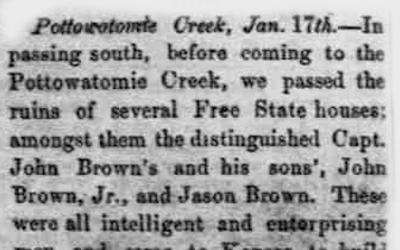
Description
This 1857 article from Kansas newspaper, The Herald of Freedom, recounts the life and actions of "Old Capt. John Brown" and his sons, John Brown, Jr., Jason Brown and Frederic Brown. The description of the family frames the men as "the most…
"A Contrast" - The Herald of Freedom Article, November 19, 1859
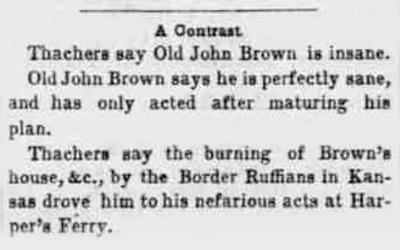
Description
This article appeared in Kansas' The Herald of Freedom newspaper in November 19, 1859. The article was published after the Harpers Ferry Raid. The author contrasts John Brown's actions and motives through how he described it compared to how Solon Otis…
"John Brown, the Insurgent" - Alexandria Gazette Article, November 21, 1859
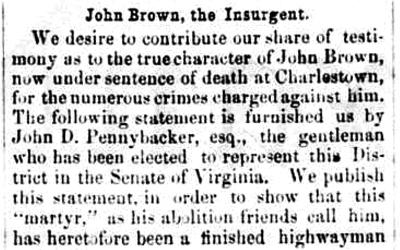
Description
This article from the Alexandria Gazette focuses on the testimony of a "Mr. Pennybacker," who recounts his knowledge of John Brown and his actions in Kansas. The purpose of highlighting this testimony was to try to show Brown as a "…
Eyewitness Account from "John Brown in Iowa - An Exciting Journey to the Front," May 3, 1883
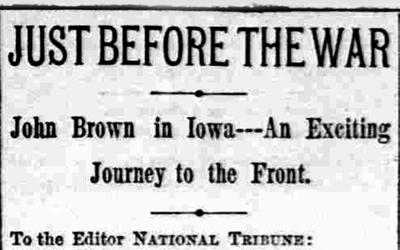
Description
This newspaper article was written by an eyewitness to John Brown’s actions in Iowa in 1883. The author was E.H. Gregg, a soldier, who spoke about the "taste of rebel malignity" in relation to John Brown and his actions. The article appeared in the Washington, D.C.,…
"John Brown's Last Visit to Tabor (Iowa)" from The Annals of Iowa, 1898
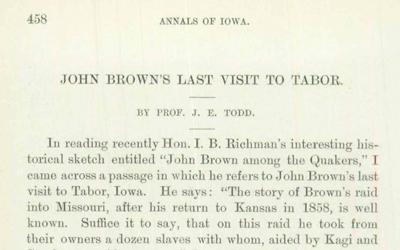
Description
The town of Tabor in southwestern Iowa played a significant role in the 1850s because it was located in a strategic position to impact the future of slavery in the West. John Brown used the town square for camping and drilling exercises before his raid on…
"Execution of Capt. John Brown" Broadside, 1859
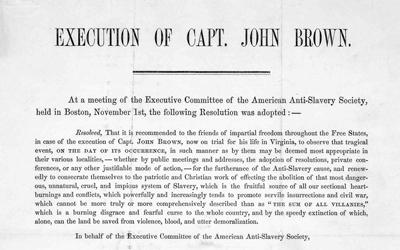
Description
This image is a broadside (poster) published by the American Anti-Slavery Society in Boston in 1859 about the execution of abolitionist John Brown. The broadside describes the struggle between the anti-slavery movement and the "dangerous, unnatural, cruel and…
John Brown's Address to the Virginia Court, 1859

Description
The document features the words of John Brown before he received a sentence for the charge of treason in a Virginia courtroom. Brown would receive the sentence of death for his participation in the raid at Harper's Ferry. The raid was an effort by armed…
Portrait of John Brown, December 12, 1859
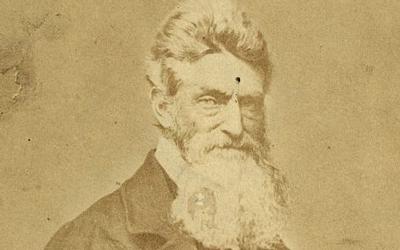
Description
The portrait is of abolitionist John Brown and was published 10 days after he was executed for charges of treason against the United States. The photograph shows a three-quarter length portrait of Brown with beard at the age of 59.
Illustration of "Old John Brown’s Career," 1860
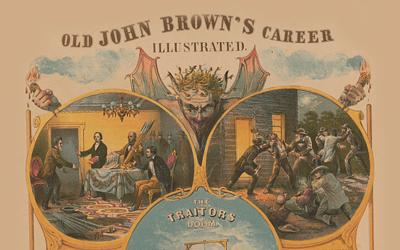
Description
The illustration highlights John Brown's movements in Kansas and Virginia. The print shows five vignettes from the life of the abolitionist, three related to "doing his Kansas work" and the fourth "commencing his Virginia work," while the fifth vignette, at center, showed…
"John Brown's Body" Song, 1861
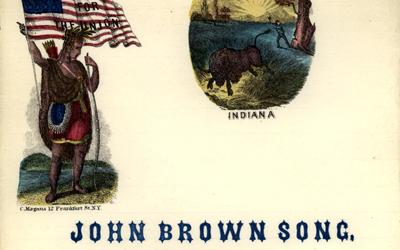
Description
Great songs sometimes seem to have a life of their own and survive by adapting to changing times and sensibilities. The song we now know as "The Battle Hymn of the Republic" has endured for more than 150 years and during that time underwent several dramatic changes in…
"Heroes of the Colored Race," 1881
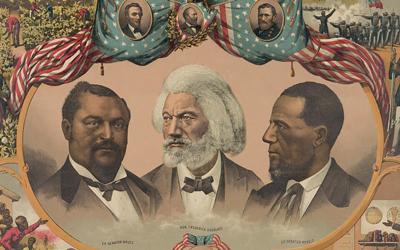
Description
The print shows head-and-shoulders portraits of Blanche Kelso Bruce (left), Frederick Douglass (center) and Hiram Rhoades Revels (right) surrounded by scenes of African-American life. The image also features portraits of Jno. R. Lynch (top left), Abraham Lincoln (top center…
Additional Resources:
- National Park Service: Harpers Ferry National Park Video Interview with Stephen B. Oates
The audio and video clips capture an interview with Dr. Stephen B. Oates at Harpers Ferry National Historical Park on June 30, 1994. Oates is an author and historian who is recognized for his work in the field of Civil War studies. The interview includes Oates answering questions like 'What impact did John Brown have upon the nation with regard to the slavery issue?" and "Why did John Brown choose violence?" - IPTV: "Iowans Helping Abolitionist John Brown"
The Iowa Public Television video highlights how Iowans helped John Brown in his cause to abolish slavery. Brown spent time in Iowa from the early to mid-1800s. The video contains photos and illustrations of Brown, his associates and their collaboration with Iowans.
Iowa Core Social Studies Standards (8th Grade)
Listed below are the Iowa Core Social Studies content anchor standards that are best reflected in this source set. The content standards applied to this set are middle school-age level and encompass the key disciplines that make up social studies for eighth grade students.
| No. | Standard Description |
| SS.8.13. | Explain the powers and responsibilities of citizens, political parties, and the media in a variety of governmental and nongovernmental contexts. (21st century skills) Examples of historical and contemporary ways that societies have changed. |
| SS.8.21. | Analyze connections among early American historical events and developments in broader historical contexts. |
| SS.8.22. | Explain how how and why prevailing social, cultural, and political perspectives changed during early American history. |
| SS.8.23. | Explain multiple causes and effects and developments in early American history. |
| SS.8.24. | Critique primary and secondary sources of information with attention to the source of the document, its context, accuracy, and usefulness such as the Declaration of Independence, the Bill of Rights, the Constitution, Washington's Farewell address, the Louisiana Purchase treaty, Monroe Doctrine, Indian Removal Act, Missouri Compromise, Dred Scott v. Sanford, and the Treaty of Guadalupe-Hidalgo. |